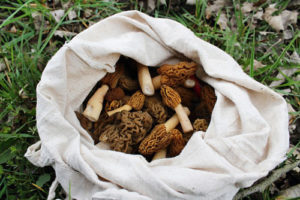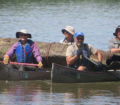 No, it’s not the white tail deer, the wild turkey, or the small mouth bass. Perhaps the most challenging species to hunt in Iowa is the morel. This perfectly camouflaged, clever little mushroom taunts us every spring, often randomly popping out in new locations for perhaps only a few fleeting days when the weather conditions are just right, and dares us to pick them as we too often walk right past them in oblivion on a woodland foray.
No, it’s not the white tail deer, the wild turkey, or the small mouth bass. Perhaps the most challenging species to hunt in Iowa is the morel. This perfectly camouflaged, clever little mushroom taunts us every spring, often randomly popping out in new locations for perhaps only a few fleeting days when the weather conditions are just right, and dares us to pick them as we too often walk right past them in oblivion on a woodland foray.
Morel mushrooms are one of Iowa’s many edible wild plants. There are multiple species of mushrooms around the world that can be eaten, but the wild morel is considered the most prized. Like all hunters, morel harvesters often keep their favorite foraging locations a secret, and pass on this information to younger generations in their families. That is because a good harvest of these prized mushrooms may go for around $25 per pound if they are fresh. Many organic supermarkets sell dried morels in one ounce packages at ridiculously high rates, which often translate to more than $350 per pound! Morels are expensive because they are highly valued for their flavor, easily perishable, light weight, and notoriously difficult to grow on your own. So most morels have to be picked in the wild.
Morel mushrooms have a wonderfully meaty, nutty taste, and can be used in many recipes. They range in size often from one to six inches, and have a beautiful airy, cavernous cap. They are best when harvested fresh from the wild, and are particularly good in a hunter’s omelet breakfast. Many terrific websites on morel hunting clubs, morel recipes, and mushroom identification can be found easily on the internet. Google searches can also produce maps that show when morels are most likely to be popping up out of the earth in your area, based on current weather conditions around the country.
Hunting for morels is an annual spring ritual for many in Iowa. Morels grow in many states, particularly those in the south and the Midwest. The best time to go morel hunting would be in the spring, usually before leaves have fully come out on trees, so that sunlight is penetrating the woodland floor and warming the earth. Some of the best days to find these secretive mushrooms are when the temperatures are in the 60-80 degree range, particularly on bright sunny days after rain. If small spring woodland plants are starting to emerge from the earth, so too will the morel in Iowa’s greenbelts and forests. Some of the best places to look would be around decaying and dying large trees, where they may poke their delicious caps out from under dead leaves. Also, due to their spores and wind patterns, look for morels in the same general area around each other. Where there is one, there are often many. Morels are notoriously difficult to spot in the leaf-covered, moist, warm forest floors due to their camouflaged brown and black colors. But once one is spotted, it is usually easier to see the others right around you, hiding in their stillness. Morel hunters often use walking sticks to push back dead foliage on the forest floor and expose the morels.
As with all wild edible plants, morel hunters should be 100% certain that they are harvesting the correct species of mushroom, as some can be toxic to humans. For new morel foragers, it is best to go on a journey in the woods with local park rangers or experienced guides that can teach you how to identify morels and other edible wild plants properly and safely. So this spring in between turkey hunting and the summer fishing season, take the whole family on a wild mushroom foraging expedition in Iowa’s woodlands, and let them experience one of best outdoor adventures the state has to offer for all ages.














